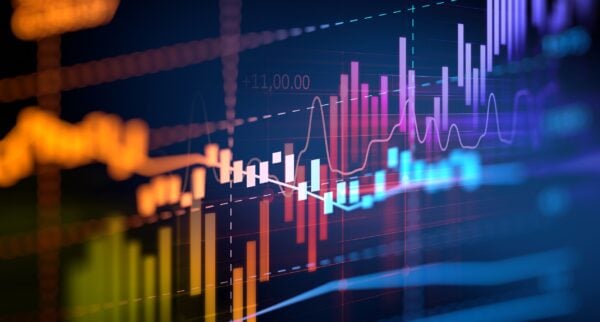
Inflation is a predator that can bite you twice. First you pay higher prices for the things you buy. Then, if you borrow to buy those things, you pay again with higher credit card interest rates because rising inflation tends to push those rates up.
The way economic events are going, those bites may be about to become a little bit deeper. Experts are growing increasingly concerned about rising inflation. So, you should also expect rising credit card rates.
While you can’t control the economy, you can prepare your household finances so you’re less exposed to the double bite of inflation.
Growing concern about rising inflation
In mid-April, Federal Reserve Chair Jerome Powell expressed concern that new tariffs could cause “higher inflation and slower growth.”
Powell’s comments echoed some of the investor sentiment that has sent financial markets on a roller-coaster since tariffs were announced.
Already, the Fed has raised its forecast for inflation twice since last September – and that was before April’s tariff announcements.
If all this talk about inflation seems like déjà vu, it’s not your imagination. The economy just endured a bout of high inflation a few years ago. In that case, the disruption of supply chains and labor shortages due to the COVID-19 pandemic caused prices to soar around the globe.
In a way, tariffs are having a similar effect. It’s not just that tariffs directly add to the cost of imported goods. The similarity with the pandemic is that confusion over tariffs threatens supply chains even for domestic producers that use parts or materials from other countries. So, in addition to the cost of tariffs, supply chain disruptions may create shortages that push prices even higher.
How inflation affects credit card interest rates
What does this have to do with credit card interest rates? Like most interest rates, credit card rates are very sensitive to inflation. Rising inflation reduces the purchasing power of the money credit card companies get back from borrowers. So, credit card companies tend to raise interest rates in times of inflation to compensate for this.
You can see an example of this in how credit card rates responded to the pandemic-era inflation a few years ago:
- At the end of 2019, the Consumer Price Index (CPI) was up by 2.3% for the prior year and the average credit card rate was 16.88%.
- When the pandemic shut down consumer demand at first, it caused inflation to fall. By the end of 2020, inflation was just 1.3% and the average credit card rate had fallen to 16.28%.
- Then consumer demand started to come back, but supply chains couldn’t keep up. The resulting shortages caused inflation to soar. By mid-2022 it peaked at 9.0%. Credit card rates rose in response, eventually reaching 23.37% in the third quarter of last year.
- Inflation began to decline in the second half of 2022 and fell throughout 2023 and 2024. By the end of the first quarter of 2025, it was down to 2.4%. Meanwhile credit card rates had eased to 21.91%.
There are other things that affect credit card rates, so those rates don’t move in lockstep with inflation. Also, regulations limit how quickly credit card companies can raise rates, so they’ll often be a little behind in reacting to rising inflation.
It’s also noteworthy that having been burned by a surge of inflation, credit card companies have been very cautious even as inflation rates have eased. By the end of the first quarter of 2025, inflation was just 0.1% higher than it was when the sequence of events described above began. And yet, the average credit card rate had eased just 1.46% from its peak, and remained 5.03% higher than it was at the end of 2019.
With credit card rates already elevated, they may not be as quick to rise as they did the last time inflation surged. At the very least though, if inflation starts climbing it will jeopardize the chances of consumers getting any more relief from falling credit card rates.
The impact of inflation on credit card debt
As for the double bite inflation can take out of household budgets, higher credit card rates are just part of the story. Inflation can also cause the amount of credit card debt outstanding to rise quickly.
As the cost of living rises, households find themselves having to spend more just to maintain the same standard of living. When this leaves their paychecks a little short, many borrow on their credit cards to make up for it.
Here’s a recent example of how inflation has caused credit card debt to soar:
- The years 2013 through 2020 marked a period of unusually low inflation. Over that period, total consumer credit card balances grew at a rate of just 2.37% a year.
- The higher inflation that followed 2020 has caused credit card balances to grow at rate of 10.27% a year since then.
So, inflation has a magnifying effect on cost-of-living increases. There are rising prices themselves. Then, you may add 20% or more in credit card interest on top of those prices if you borrow to make ends meet and can’t quickly pay off that debt.
Strategies for paying off credit card debt in an inflationary environment
There are ways of managing credit card debt during inflationary periods to make this double bite out of your budget less severe. Here are some things you should do:
- Sustainable budgeting. This means working out a budget that doesn’t rely on borrowing. Otherwise, you’re only going to find it harder each month to pay your expenses plus your growing debt payments.
- Pay down existing balances. Always try to pay more than the minimum required amount. Put any extra money towards the highest interest debt first, because that way your payments will have the most impact.
- Consider refinancing credit card debt. A 0% balance transfer card or a personal loan can help you lower the interest rate on your existing credit card debt. However, for this to work you need a plan to pay off the new debt without building your credit card balances back up.
- Work on your credit score. Making your payments on time and steadily reducing your balances should work towards this. That can help you retain access to credit when you need it, plus qualify you for better credit terms.
- Shop for the best credit card rates. As long as you have credit card debt, you should make sure it’s as cost-effective as possible by shopping around. This is an especially good idea once you start improving your credit score, because you may find you qualify for more and better offers.
➤ SEE MORE:Best low interest credit cards
The good news is that higher inflation hasn’t hit the economy yet. That gives you more of a chance to protect yourself by preparing in advance with the above methods.


